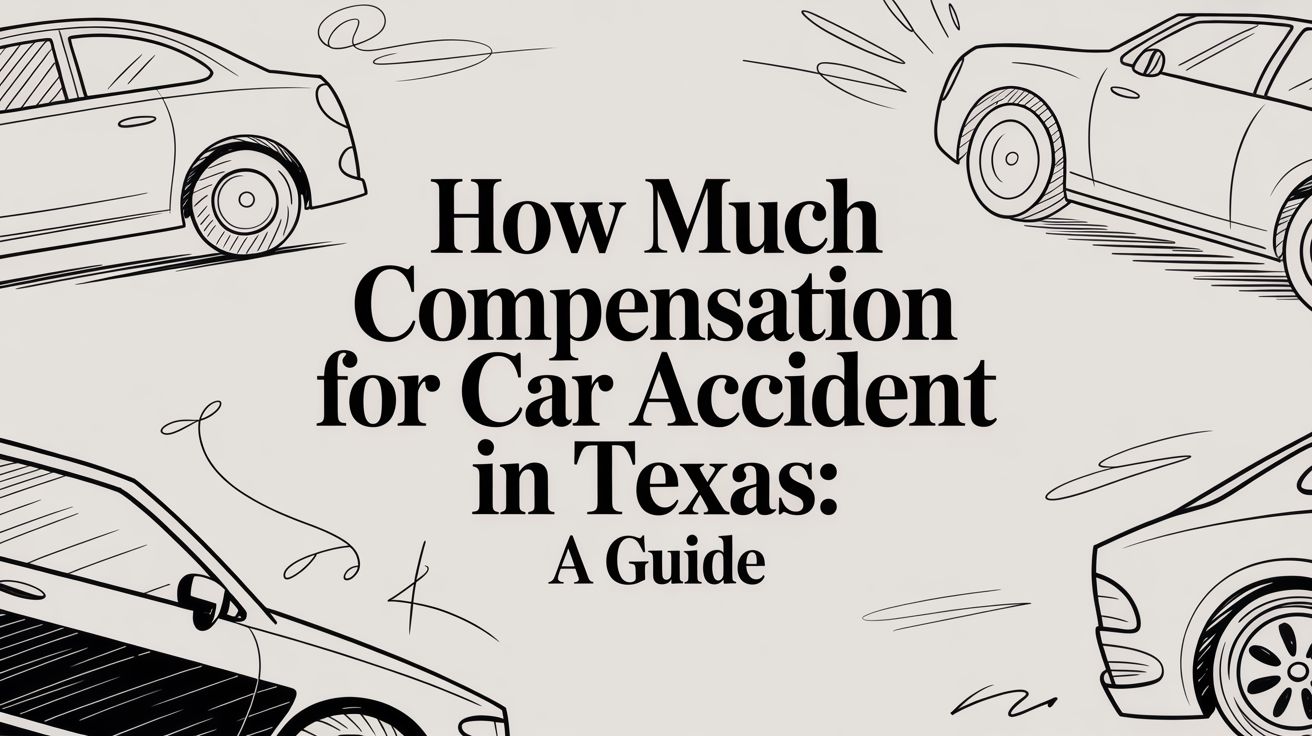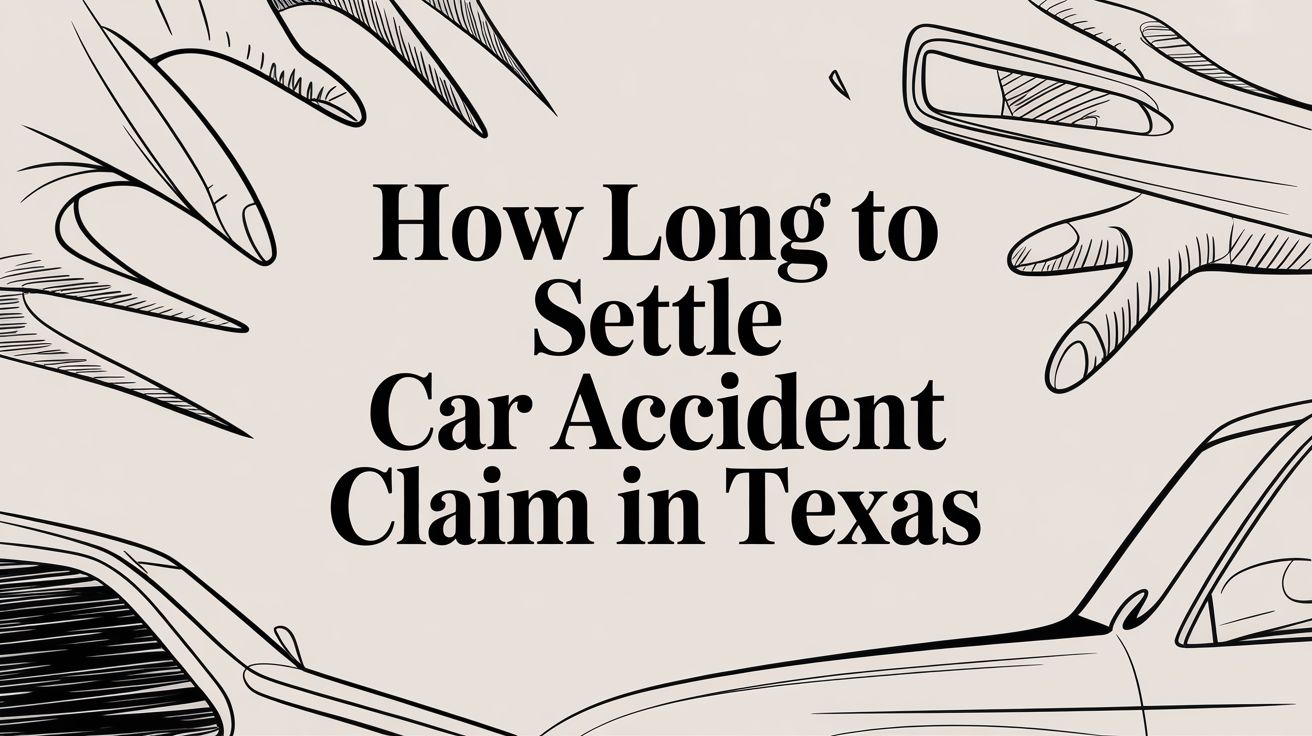Losing a loved one is a devastating experience, and the pain is only deepened when their death was caused by someone else's carelessness. A serious accident can change your life in seconds — but you don’t have to face it alone. If you're navigating this unimaginable loss, you are likely filled with questions about your family's rights and how to seek justice.
When you file a wrongful death lawsuit in Texas, you're taking a necessary step to hold a negligent party accountable and secure your family's financial stability. Think about a distracted driver causing a fatal wreck on a Houston freeway—that preventable act of negligence is what gives eligible family members grounds to file a claim.
This guide is here to offer clarity during an impossibly difficult time. While legal action might feel overwhelming right now, it is often the only path to accountability and the financial security your loved one would have wanted for you.
Your First Steps After a Devastating Loss

The moments and days after losing a loved one due to someone else's negligence are often a blur of grief and confusion. You aren't just mourning; you're suddenly facing overwhelming questions about what justice looks like and how your family will move forward.
Understanding the Purpose of a Wrongful Death Claim
It's important to understand what a wrongful death lawsuit is meant to achieve. This is not about putting a price on a person's life—that would be impossible. Instead, the goal is twofold:
- Accountability: It forces the negligent person or company to answer for the devastating harm they caused.
- Financial Stability: It provides compensation for the very real losses—both financial and emotional—that your family is now facing.
For example, after a Houston freeway crash caused by a fatigued commercial truck driver, a claim filed by a Texas wrongful death lawyer seeks to recover damages for the family's lost income, the loss of companionship, and their profound mental anguish. A wrongful death claim provides a legal path for families to seek justice and transforms a personal tragedy into a formal demand for accountability.
Navigating the Emotional and Practical Challenges
The emotional toll of a sudden loss is immense, and managing practical responsibilities at the same time can feel impossible. As you work through the immediate aftermath, it’s critical to find compassionate guidance on how to deal with grief.
You don't have to carry this weight by yourself. Seeking support from an experienced Houston personal injury attorney can lift the burden of dealing with insurance companies and complex legal procedures. A compassionate legal team will handle every aspect of the case, giving you the space you need to focus on healing with your family.
Who Can File a Wrongful Death Claim in Texas?
When your family is reeling from a sudden, preventable loss, one of the first and most critical questions is, "Who has the right to seek justice?" In Texas, the law is very specific about who can file a wrongful death lawsuit. Knowing these rules is a vital first step in ensuring your family’s pursuit of accountability begins on solid legal ground.
The Texas Civil Practice and Remedies Code grants this right to a small circle of immediate family members. This legal structure is designed to protect the closest surviving relatives who have suffered the most direct loss.
Who Is Eligible to File a Lawsuit?
In Texas, only the following individuals have the legal standing to bring a wrongful death action:
- The Surviving Spouse: The person who was legally married to the deceased at the time of their death.
- The Surviving Children: This includes biological and legally adopted children, regardless of their age.
- The Surviving Parents: The mother and father of the deceased.
These family members can file a lawsuit individually, or they can choose to file together as a group. For example, if a construction worker in Dallas is fatally injured because of an employer’s negligence, his wife and two adult children could join together in a single lawsuit against the responsible company. A unified approach often strengthens the case and streamlines the legal process.
Who Is Not Eligible Under Texas Law?
Just as important as knowing who can file is understanding who cannot. This can be a painful reality for many grieving families. Texas law does not extend the right to file a wrongful death claim to other relatives, no matter how close the relationship was.
Those who are not eligible include:
- Siblings (brothers and sisters)
- Grandparents or grandchildren (unless a grandchild was legally adopted by the deceased)
- Unmarried partners, even in long-term, committed relationships
- Aunts, uncles, cousins, or any other extended family members
This can be incredibly difficult for siblings who have lost a brother or sister, or for a life partner who wasn’t legally married. While their grief is immense and their loss is real, Texas law does not provide them a direct path to file a wrongful death lawsuit on their own behalf.
What Is the Three-Month Rule?
Texas has a specific provision that applies when eligible family members are unable to take immediate action. This is often referred to as the "three-month rule."
If none of the eligible individuals—the spouse, children, or parents—file a wrongful death lawsuit within three calendar months of the date of death, the personal representative or executor of the deceased's estate is then permitted to file the claim. However, they can only do so if a family member has not specifically requested that they refrain from filing.
This rule acts as a critical safeguard. It ensures the opportunity to hold a negligent party accountable isn't lost just because a family is too overwhelmed with grief to act in the immediate aftermath of their tragedy. A dedicated wrongful death lawyer in Texas can help your family understand this timeline and ensure all deadlines are protected.
Building a Strong Wrongful Death Case

A strong wrongful death case is not built on emotion, but on a solid foundation of evidence proving the other party was legally responsible for your loved one's death. Your Texas wrongful death lawyer’s job is to prove the four key elements of negligence required by state law. This process creates a clear, undeniable story for the insurance company or a jury—one that shows exactly how another person's or company's careless actions led to your family’s tragedy.
The Four Elements of a Texas Wrongful Death Claim
To hold someone accountable, your legal team must prove four specific things. Think of these as the pillars holding up your entire case. If even one is missing, the claim cannot succeed.
- Duty of Care: First, we must show that the defendant (the at-fault party) owed your loved one a legal duty to act with reasonable caution to avoid causing harm. For example, every driver on a Texas highway has a duty to operate their vehicle safely and follow traffic laws. A doctor has a duty to provide a standard level of medical care.
- Breach of Duty: Next, we prove the defendant violated, or "breached," that duty. This is the act of negligence. It could be a driver who was texting instead of watching the road, a surgeon who failed to follow standard medical procedures, or a truck crash lawyer in Houston might prove that a trucking company failed to properly maintain its fleet.
- Causation: The third pillar connects the breach of duty directly to your loved one's death. The fatal injuries must be the direct result of the defendant's negligent act, not some other unrelated event.
- Damages: Finally, we demonstrate that your family suffered quantifiable losses, or "damages," because of the death. This includes financial losses like lost income and medical bills, but also non-economic damages like mental anguish and the loss of companionship.
Proving these four elements is the core of any successful wrongful death lawsuit. It is a detailed process that a skilled Texas personal injury lawyer handles with experience and care.
Gathering the Evidence That Tells the Story
Evidence is the language of the legal system. One of your attorney’s most critical roles is to gather and organize every piece of evidence needed to build an irrefutable case. This involves weaving together documents, statements, and expert analysis to tell a compelling story of what happened.
Key pieces of evidence often include:
- Official Reports: Police accident reports, workplace incident reports, or findings from government agencies like OSHA provide an official account of the event.
- Medical Records: These documents detail the injuries your loved one sustained, the medical treatments they received, and the official cause of death.
- Eyewitness Statements: Testimony from people who saw the accident can provide powerful, firsthand accounts that support the official reports.
- Expert Witness Analysis: In complex cases, we often rely on experts. An accident reconstructionist can recreate a crash scene, while a medical expert can explain precisely how a doctor's error led to a fatal outcome.
For instance, in cases involving fatal car accidents, your attorney might hire an expert to analyze a truck's "black box" data to prove the driver was speeding moments before impact.
Evidence Checklist for a Texas Wrongful Death Claim
Building a strong case means being thorough. Here's a look at the types of evidence we typically gather and why each piece is so important.
| Type of Evidence | Why It's Important | Example |
|---|---|---|
| Official Reports | Provides a neutral, third-party account of the incident. | A Houston police report detailing a drunk driving accident. |
| Medical Records | Establishes the cause of death and links it to the incident. | Emergency room records and the death certificate. |
| Financial Documents | Helps calculate economic damages like lost income. | Pay stubs, tax returns, and employment records. |
| Witness Testimony | Offers firsthand accounts that can confirm negligence. | A statement from a pedestrian who saw a car run a red light. |
| Expert Opinions | Provides specialized analysis for complex situations. | An engineer's report on a defective product. |
| Photos & Videos | Offers visual proof of the scene, vehicles, or conditions. | Traffic camera footage or photos of the crash scene. |
A successful claim is built piece by piece with undeniable proof. Your attorney's role is to gather every report, statement, and expert opinion needed to show not just what happened, but why the defendant is legally responsible for your family's loss.
The Reality of Wrongful Death Litigation
Many people believe lawsuits are filed frequently, but the data tells a different story. Filing a wrongful death lawsuit is far less common than you might think, particularly in cases of medical malpractice—a major source of these claims.
For example, the National Practitioner Data Bank reported just 3,046 medical malpractice payments for wrongful death claims in a recent year. Some estimates suggest that only about 5% of deaths caused by medical errors result in a malpractice payout. This gap shows that many families may not realize they have the right to seek justice.
This makes having a dedicated legal advocate on your side even more crucial. In some situations, determining the exact cause of death is the most critical step. Families may need to seek out more specific information through resources about private autopsies due to wrongful death cases. This can provide the vital evidence needed to strengthen a claim, especially if initial findings were unclear. Your legal team can help you decide if this is a necessary step for your case.
What Damages Can Be Recovered in a Wrongful Death Claim?
Putting a price on the life of someone you love is not just impossible; it’s a painful thought. In the eyes of Texas law, calculating damages isn’t about assigning a monetary value to a person. It’s about quantifying the immense losses your family has been forced to endure, providing financial stability, and holding the negligent party accountable.
Texas law provides two distinct legal avenues to accomplish this: a wrongful death claim and a survival action. Each is designed to address different types of harm.
The Wrongful Death Claim: For the Family’s Loss
A wrongful death claim is brought by the eligible surviving family members—the spouse, children, and parents. The purpose of this claim is to compensate them for the personal losses they have suffered because their loved one was suddenly taken from them.
This type of claim is meant to cover a wide range of damages, both tangible and intangible:
- Lost Earning Capacity: This calculates the income, benefits, and financial support your loved one would have provided to the family over their expected lifetime.
- Loss of Companionship and Society: This addresses the profound, personal loss of your loved one’s presence—their love, comfort, guidance, and partnership.
- Mental Anguish: This is compensation for the deep grief, sorrow, and emotional pain the family has been forced to endure.
- Loss of Inheritance: This accounts for the assets the deceased would have likely saved and passed on to their family had they lived a full life.
For example, after a fatal truck crash on I-45 near Houston, a surviving spouse doesn't just lose her husband's paycheck. She loses her partner and his support—losses that Texas law rightfully recognizes as significant and compensable.
The Survival Action: For the Deceased’s Losses
A survival action is a different legal tool. It's filed on behalf of the deceased person’s estate to recover the damages that your loved one could have claimed themselves if they had survived the incident.
In simple terms, a survival action allows the personal injury claim of the deceased to "survive" their death. This ensures the at-fault party is still held responsible for the harm they caused directly to the victim before they passed away. Any damages recovered are paid to the estate and then distributed to heirs. These damages typically include:
- Medical Expenses: All costs for medical care from the moment of the incident until their death.
- Funeral and Burial Costs: The reasonable and necessary expenses for the funeral and burial services.
- Conscious Pain and Suffering: This compensates for the physical pain and emotional distress the victim experienced between the time of their injury and their death.
A skilled wrongful death lawyer in Texas will carefully evaluate both types of claims to ensure your family can pursue every dollar of compensation available under the law.
Wrongful Death vs. Survival Action Damages in Texas
To make it clearer, let’s break down what each type of claim covers. Think of the wrongful death claim as compensation for the family’s future without their loved one, while the survival action addresses the harm done directly to the victim before they died.
| Type of Damage | Wrongful Death Claim (For Family) | Survival Action (For Estate) |
|---|---|---|
| Lost Earning Capacity | Yes – The family's loss of future financial support. | No |
| Loss of Companionship | Yes – The intangible loss of the relationship. | No |
| Mental Anguish | Yes – The family's emotional suffering. | No |
| Medical Bills | No | Yes – The costs incurred by the victim before death. |
| Funeral Expenses | No | Yes – Paid for by the estate. |
| Victim's Pain & Suffering | No | Yes – For the suffering endured by the deceased. |
Understanding these differences is key. Your Houston car accident attorney will know how to structure the legal strategy to maximize the recovery for both the individual family members and the estate.
The Reality of Wrongful Death Payouts
While news headlines sometimes flash multi-million dollar verdicts, the financial outcomes of wrongful death lawsuits vary widely. For instance, the average payout for a U.S. medical malpractice claim hovered around $420,000 in 2023.
However, a closer look at medical malpractice statistics reveals a more complex picture. Out of 11,440 claims, the largest group—about 3,200—resolved for less than $100,000, while only about 1,300 resulted in payouts over $1 million. This shows how much outcomes depend on the specific facts of the case, the severity of the negligence, and the quality of your legal team. An experienced Texas attorney is vital for building a case that truly reflects the full value of your family's loss.
Navigating the Texas Wrongful Death Legal Process
When you're grieving, the last thing you want is a legal battle. But understanding the roadmap can bring a sense of clarity during an overwhelming time. While every case is unique, the journey from filing a claim to finding a resolution follows a structured path. A dedicated wrongful death lawyer in Texas will manage every detail, allowing you to focus on what truly matters—healing.
How Long Do You Have to File a Claim in Texas?
In Texas, there's one deadline you absolutely cannot miss: the statute of limitations. You have just two years from the date of your loved one's death to file a lawsuit. If you miss this window, the courts will almost certainly bar your case forever, no matter how strong your evidence is.
The two-year clock starts ticking on the day of the death, not the day of the accident. While that may seem like a lot of time, building a solid wrongful death case requires careful investigation. Acting quickly is crucial to preserving evidence and protecting your family’s right to seek justice.
Filing the Petition and the Discovery Phase
The legal process officially begins when your attorney files a formal complaint, known as a petition, with the proper Texas court. This document outlines who is being sued, the reasons why (the specific negligence), and the damages your family is seeking. Once filed, the defendant is formally served and must provide a legal answer.
This marks the start of the discovery phase. During this period, which can last for several months, both sides exchange information and evidence. It's a critical stage where your attorney will:
- Send written questions (interrogatories) to the defendant.
- Request key documents, like internal company reports or a truck driver’s logbook.
- Take depositions, which are sworn, out-of-court testimonies from witnesses, experts, and the defendant.
The purpose of discovery is to uncover all the facts and build the strongest case possible before entering negotiations or a trial.
The infographic below breaks down the two main types of claims pursued in this process—one for the family’s direct losses and one for the estate.

This helps clarify how Texas law addresses both the family’s personal, emotional losses and the financial harm suffered by your loved one’s estate.
Negotiation, Settlement, and Trial
The vast majority of wrongful death cases are resolved through a negotiated settlement without ever going to a courtroom. Once discovery is complete, your attorney will have a clear picture of the case’s strengths and will typically enter into serious negotiations with the defendant’s insurance company. If a fair agreement is reached, the case is settled.
If the insurance company refuses to make a fair offer, the case may proceed to trial. While a trial can be a longer and more emotionally difficult process, sometimes it is the only way to achieve full justice. A trial-tested attorney prepares every case as if it will go before a jury. This ensures we are always ready to fight for you in court, following a methodical approach similar to the steps involved when you file a personal injury claim in Texas.
You Don't Have to Face This Alone
The legal process for a wrongful death claim is a heavy burden to carry, especially when your family is grieving. You are not expected to handle this on your own. Seeking justice for your loved one is a courageous and necessary step, and having a dedicated legal team in your corner can make all the difference.
Taking action within the two-year statute of limitations is critical. Partnering with a firm that understands the nuances of Texas wrongful death law is paramount to protecting your family's rights. Our team is here to help families like yours find a clear path forward after a devastating loss.
Your Next Step Starts with a Conversation
We invite you to reach out for a free, compassionate consultation to discuss your case and understand your options. There is no obligation—it's simply a chance for you to get the answers you need from an experienced wrongful death lawyer in Texas.
Choosing the right legal partner is one of the most important decisions you will make. Our firm works on a contingency fee basis, which means you pay absolutely nothing unless we win your case. Let us provide the clarity and unwavering support you need to secure justice for your loved one and financial stability for your future. Before making a decision, you can also learn more about how to choose the right personal injury lawyer to ensure you feel confident in your choice.
Common Questions in Texas Wrongful Death Cases
When families come to us after a devastating loss, they have many questions. Here are some of the most common ones we hear, along with straightforward answers.
How Long Does a Wrongful Death Lawsuit Take?
The honest answer is: it depends. Every case has a unique timeline. A case where fault is clear and the insurance company is motivated to settle could resolve in a matter of months. However, if the situation is more complex—with multiple at-fault parties or a dispute over the cause of death—it will take longer. If a case must go to a jury trial, it could take a couple of years. Once we review the specifics of your situation, we can provide a more realistic timeframe.
What If a Government Agency Was Responsible?
Yes, you can sue a government entity in Texas, but the process is governed by a special law called the Texas Tort Claims Act, and the rules are very different and strict. The biggest challenge is the deadline. You have a much shorter window to give the government formal notice of your intent to file a claim—sometimes as short as 90 days. Missing this deadline could permanently bar you from seeking compensation. It is absolutely critical to contact an experienced Texas personal injury lawyer immediately if you suspect a government agency was at fault.
Can We Still File If Our Loved One Was Partially at Fault?
In many cases, yes. Texas law follows a rule called modified comparative responsibility, also known as the 51% bar rule. This means your family can still recover damages as long as your loved one was 50% or less responsible for the incident. The court will determine the percentage of fault, and your family's final compensation will be reduced by that amount. For example, if a jury finds your loved one was 10% at fault for the accident, the total damage award your family receives would be reduced by 10%.
Losing a family member is an unimaginable tragedy, and navigating a complex legal system while grieving can feel impossible. But recovery is possible, and legal help is available. At the Law Office of Bryan Fagan, PLLC, our compassionate attorneys are here to offer the guidance, clarity, and support you deserve. Contact us today for a free, no-pressure consultation to discuss what happened and learn how we can help you fight for justice. Schedule your free consultation online or give us a call now.








